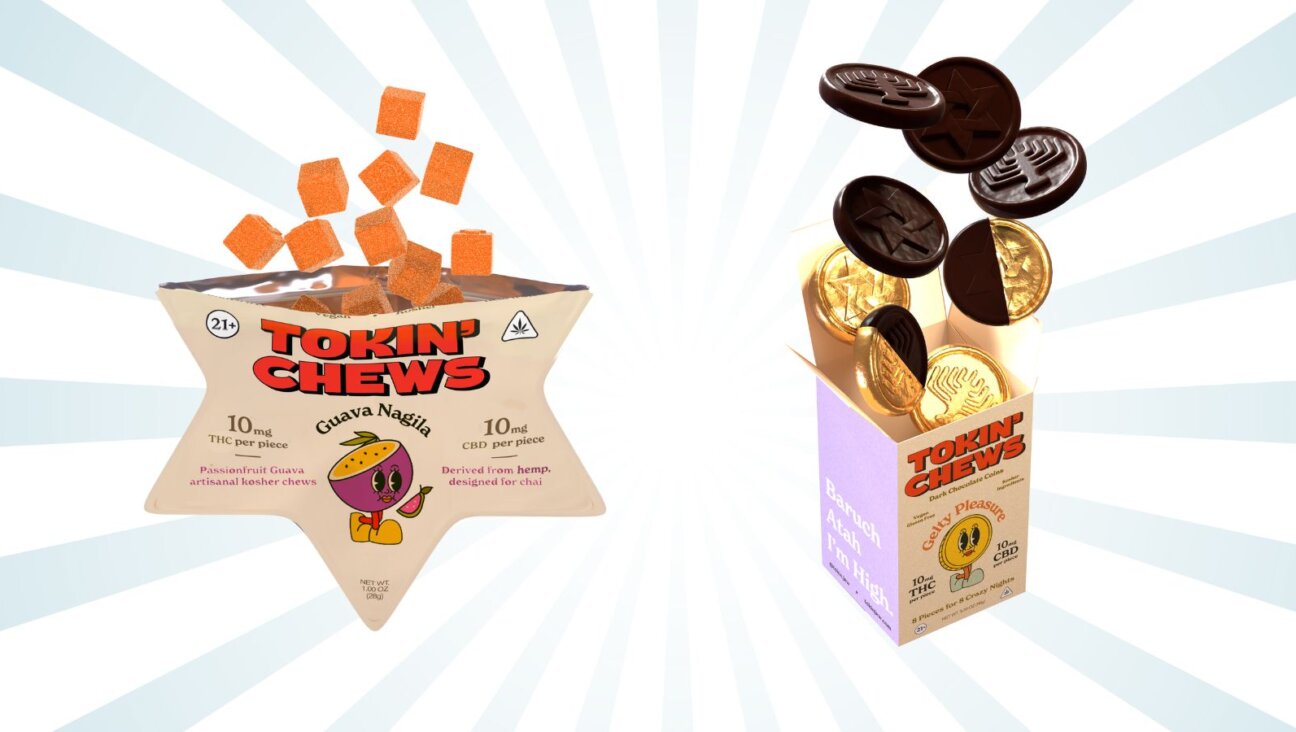The Jew-witch Herbal: DIY Juniper Vinegar feeds your gut and cleans your grout

Graphic by Angelie Zaslavsky
“A Jewitch Herbal: Mystical Reflections on Food, Nature and Urban Farming” is a regular column by Devorah Brous charting the ways we can use mystical Jewish wisdom, earth-based practices and herbal wellness to reconnect with ourselves in harmony with nature. Brous is an urban homesteader, lifecycle ritualist, and green consultant in Los Angeles. Find her online offerings for the ancient Sabbatical year @Dev.Brous

Juniper berries
How amazing is juniper?
The juniper tree produces berries with medicinal and culinary properties that are widely used to flavor food, flush the urinary tract, clear lungs—and clean surfaces.
Aside from an 850 year-old juniper tree growing in northern Sinai, there are four species of juniper that grow in Israel and the West Bank. Three of the uncultivated varieties appear on different levels of Israel’s endangered list according to the Red Data Book.
Israel is not alone – in fact a recent study performed by the Global Tree Assessment found that 30% of the world’s trees are endangered. With #COP26 just behind us, now is the time to contemplate regeneration and find ways to bring this and other native trees back to diversify our landscapes, such as Israel’s pine-dominant lands.
This Hebrew year is a sabbatical year, or shmita, a time when the land of Israel is left fallow to replenish the nutrients and regenerate.
The Torah of Shmita invites us to forage in order to leave the land fallow. We’re told to only forage only what we can carry. The Torah is in line with the latest in regenerative agroecology: for regeneration we practice balance and moderation, it’s a chance to reset after pandemic-hoarding.
So here in the Diaspora, you can adopt shmita practices when it comes to junipers: Go forth and forage some juniper berries to toss into your food.
Make sure you only gather Juniper species that are edible and native to your microclimate—at least one species I know of is not edible. Ethically harvest a small amount of juniper berries from a tree that is thriving. While the trees are not endangered here, I always love to bring something to give back to the tree (water, or a jarful of compost, etc.) after harvesting.
Juniper berries can be infused as an herbal tea. Or you can burn a small sprig of juniper leaf to clear the air—as an alternative to burning the overly-harvested white sage that is sacred to indigenous peoples. Juniper is also a traditional Native American medicinal plant and food source.
Some juniper benefits include:
•A powerful diuretic, and a source of natural yeast.
•An excellent source of vitamin C, high in antioxidants.
•An anti-inflammatory, antifungal and antibacterial.
We’ll learn how to infuse juniper berries into homemade vinegar to clean your home, or toss into your greens.
Vinegar’s benefits have stood the test of time. According to the Jewish Encyclopedia, way back when, vinegar was referred to as “the son of wine,” demoted from center stage as a flavor, and actually prohibited from being on the altar. Early accounts indicate vinegar was made by adding barley to either wine or cider. I visited a biodynamic apple orchard to learn that raw apple cider vinegar today is made after allowing hard cider to ferment. I make mine from kombucha.
Later on, during Talmudic times, a common practice was taking vinegar daily with water. We know that due to its calming effect, (and perhaps it’s effectiveness at curbing appetite) vinegar was forbidden on the Day of Atonement in Tractates Pesahim and Yoma in the Talmud. Vinegar actually became the subject of Rabbinic debate concerning the rules of fasting when R’ Giddal ben Menasseh announced it is not prohibited to drink a small amount of vinegar and water on the Day of Atonement. When this became a widespread practice, it was frowned upon yet permitted only with raw vinegar.
In other cultures, apple cider vinegar has been used since as far back as 5000 B.C. by the Babylonians for pickling, and has a long recorded history in Egypt and China. It appears to have been used as a condiment, a preservative, for dressing wounds, and as a gargle for toothaches.
Today’s science is bearing out this long cross-cultural appreciation. There is a growing body of promising evidence-based research suggesting apple cider vinegar can help reduce cholesterol, lower blood sugar levels, and improve symptoms of both diabetes and heart disease while regenerating the probiotics in the gut biome.
The malic acid and tartaric acid help balance the acid levels in the digestive tract and make nutrients available so your body can more easily absorb them. There is no shortage of writing about apple cider vinegar for detox, weight loss, and anti-aging, so I’m focused here on how to make your own vinegar with homegrown fruit.
Together, apple cider vinegar and juniper berries offer a motherload of beneficial reasons to swap out for the harmful chemicals found in household cleaning products and pesticides. In fact, it’s so healthy you can drink it or toss it on a salad—but we’re making an all-purpose cleaner instead.
The main ingredient in apple cider vinegar that provides the most potent health benefits is acetic acid. The acetic acid in vinegar kills harmful bacteria, yet unlike bleach, this happens without being corrosive to the skin, lungs, and eyes or burning body tissue.
A magical, regenerative host that lives in the apple cider vinegar, called “the mother,” is an amoeba-like starter also found in kombucha that contains strands of all the good stuff: healthy proteins, enzymes, polyphenols, and probiotics (beneficial bacteria) to aid with digestion and metabolizing of proteins, fats and minerals – so it’s teeming with reasons for you to try it while detoxing the body, cleaning the skin and scalp, as well as cleaning and disinfecting surfaces in your home.
While you might be inclined to think that bacteria is dirty and not what you want to clean your countertops, in fact, villages of bacteria, otherwise known as mother cultures, are what makes living foods alive. Mothers are all about procreating healthy bacteria. Did you know that there are 10 times more bacteria than human cells in our body, and that they perform essential support functions for our immunity? We want more beneficial bacteria in our guts, and in our soils – why not also on natural wooden furniture?
The ancient Sabbatical year is a great time to read the ingredients labeled on your household products and find products or recipes to swap out the sulfates, parabens, formaldehyde, phthalates, perfumes, preservatives, dyes, and chemical foaming agents for a homegrown and homemade product with apple cider vinegar and juniper that is good for you and good for the planet. Give it a try and let me know what you think. @dev.brous
The Remedy
Items / Ingredients to Make Your Apple Cider Vinegar:
1/2 cup unpasteurized ACV or if you’ve made Kombucha that has sat for too long and smells tart, use this to kickstart the fruit fermentation
a pound of fruit – apples, apricots, plums, etc. (Take out the core and seeds – compost or regrow!)
One lemon
Optional: Lemon Balm / Lemongrass / Lemon Verbena / Lavender + Citrus
Essential Oil
Quart-Sized or Half Gallon Mason Jar
Coffee Filter (thin towel, or muslin cloth)
Rubber Band
An open mind! You’ll get to see the process of regeneration unfold before your eyes, in the form of a murky looking layer that rises to the top of the jar. It is a friendly colony of beneficial bacteria that are fermenting the sugar and creating the acetic acid! (Discard if it has mold.)
Instructions to Make Vinegar
Give the fruit a rough cut, nothing fancy.
Put the fruit in a quart-sized or half gallon jar and fill with water until the fruit is covered. -Add 1/3 cup of unbleached sugar and stir.
Cover with a muslin cloth and a rubber band.
Label/date and set aside in a dark cabinet.
After two weeks to a month, the brew will smell like vinegar.
By now, you might be able to catch a glimpse of the regenerative mother culture growing at the surface! You can gently rinse the mother if there’s chunks of fruit on it, and put it back in the jar with the pressed out liquid.
Strain out the fruit using a muslin cloth tied over a sieve.
Keep the muslin cloth and rubber band on the top, and put the jar in a cool dark place to continue fermenting for a month, maybe more. Test your vinegar periodically, if it’s still sweet, it still needs more time to ferment. You choose when it has reached the desired balance of sweetness and acidity. (More acidity will mean better preservation down the road if you want to infuse herbs into the vinegar, more sweetness may be tastier and more palatable for cooking, etc.)
When the vinegar is fermented to your liking, transfer the mother and a small amount of vinegar, enough to cover the mother, into another jar for safekeeping for one month. Put a lid on the rest of the vinegar, or you may want to transfer it to another kind of bottle that’s more suited for cooking / serving.
Infuse Juniper in Vinegar (+ Optional Herbs and Spices)
Harvest a few handfuls of Juniper berries and leaves (I work with Juniperus californica). *Be sure to correctly identify your local species as not all Juniper is edible.
Spread the berries out to dry on a rack or a tray for a day or two, out of the direct sunlight.
Use a mortar and pestle to crush the berries and break open their cell walls. You can also use a blender to fully pulverize the berries.
Add the crushed Juniper berries to a pint-sized mason jar.
Add a handful of lemon balm chopped up including the stem and leaves.
Take off the rind of a lemon and chop into bits. Add the rind.
Cover the berries and lemon rind with your homemade Vinegar. (or source Braggs at any health food store)
Seal, label and store for one-three months in a dark cabinet.
Strain the liquid and transfer its contents to a labeled spray bottle to clean up this planet, one surface at a time.
Compost the berries and rind.
Add any 15 drops of essential oil of your liking to the spray bottle. (Tangerine is lovely!)
*Disclaimer: This information is not intended to diagnose, treat, cure or prevent any disease. I am not providing medical advice, diagnosis or treatment. Content here is not intended to be used for medical diagnosis or treatment. The information provided here is intended for general understanding and awareness only.
























